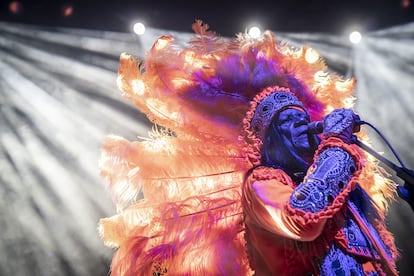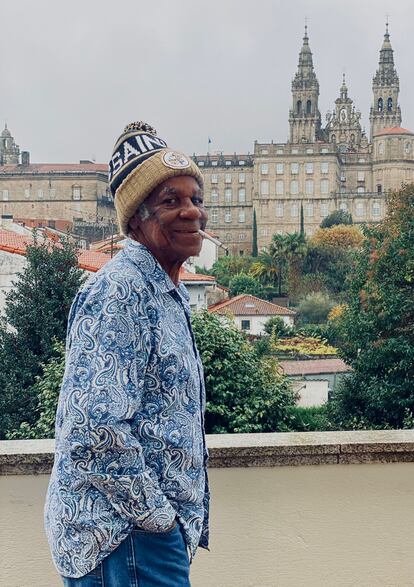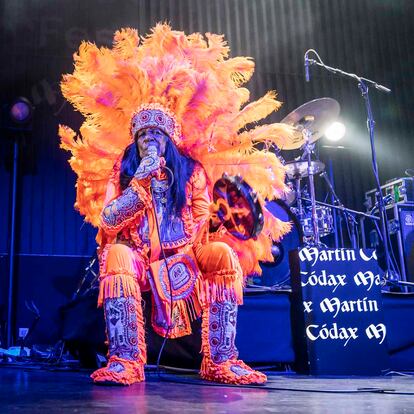Big Chief Monk Boudreaux: ‘We would dress up for Mardi Gras and they would throw us in jail’
The leader of the Golden Eagles tribe talks to EL PAÍS about Bob Dylan, James Brown and why his life is about ‘treating others better than they treat you’


The Big Chief has spent the night sewing. He emerges in the hall of the hotel and smiles a big, welcoming grin. It is Thursday, November 17, and Big Chief Monk Boudreaux is visiting Spain for the first time. At 80 years old, he is ready to explore Santiago de Compostela, the city where he will perform as part of the Outono Códax Festival, a concert series showcasing some of the best jazz, soul, and R&B music from the US and Europe. It will be a historic concert: never before has an old chief from one of the original “Mardis Gras Indian tribes” of New Orleans performed to a Spanish audience. “Take things as they come,” he says. “It never takes too long if you get there in the end.”
Monk Boudreaux is more than just a musician; he is a high-level representative of the New Orleans African American community, and a kind of spiritual leader. His deep, gravelly voice blends virtually every strand of Black American roots music: jazz, blues, soul, funk, R&B. He even delves into reggae, a genre featured on his latest album, Bloodstains & Teardrops, which last year was nominated for a Grammy in the category of Best Roots Album. This is neither a coincidence nor an experiment in a foreign sound: Jamaica’s connections with New Orleans run deep, and the city is brimming with the vibrant, mestizo spirit of Afro-Caribbean music. “We are united by feeling,” Boudreaux says, referring to the island. “We’ve been brothers since before we were born.” A huge Bob Marley fan, Boudreaux once made a pilgrimage to the mountain where the King of Reggae is buried, and recorded six songs at Tad’s International Recording Studio in Kingston. During his visit to Jamaica, he met Marley’s surviving relatives, who honored him as their “equal.”
Monk Boudreaux is undoubtedly on a par with the Rastafarian legend, and with the scores of New Orleans’ greats with whom he has performed: Professor Longhair, Allen Toussaint, Dr. John, Irma Thomas, and more. All of these musicians held Boudreaux in high regard, and often sought his counsel. Speaking with EL PAÍS before his performance in Santiago de Compostela, Boudreaux says he remembers marching in the funeral processions for Toussaint and Dr. John, in that famous “second line” – the New Orleans tradition in which a band plays somber music while the deceased is conveyed to the cemetery, but for the return procession, they march to joyful, upbeat music, and in celebration of life. The deceased are sent off amid a bedlam of winds and brass and spontaneous outbursts of dancing. “Dr. John knew everything about our tribes,” Boudreaux says. “He came to our bars and would hang out with us all day, talking with us and studying our ways.” Boudreaux remember Allen Toussaint, who died in 2015 after performing a concert in Madrid, as “a kind guy” – and kindness, he says, “is the most important thing.”
Bob Dylan once approached Boudreaux and told him he loved what he was doing. “That guy wasn’t much of a talker,” Boudreaux remembers, with a winking smile. “He seemed like a nice person, but he didn’t like to be around other people for more than a few minutes.” It was different with James Brown, he says: In the 1970s, Big Chief Monk Boudreaux and his band opened for Brown at a gig in New York. When Brown found out that the Big Chief would be performing before him, he thought about trying to get him cut from the lineup: No one could follow the show of a big New Orleans Indian Chief – not only was it disrespectful, but it would be like shooting himself in the foot. But James Brown decided not to intervene, and resigned himself to performing in Boudreaux’s shadow.

With his alligator-like movements and his hypnotic dancing, the Big Chief is always a bewitching presence on stage. There is an ancestral cadence to his every move, even his hand gestures. When he peers into you with his old smile, it is like he is looking into your soul, deciphering it. His gaze is as deep as the Mississippi, a river that flows through him like an artery. Monk Boudreaux remembers how, as a child, he would listen to Al Johnson on the radio as if the singer were an alien, transmitting sounds from a far-off planet, and how the old men in his neighborhood would sing the blues on their porches, and he would stay up late into the night listening to them. At the age of 12 he joined the Golden Eagles tribe, one of the oldest Mardi Gras Indian tribes in New Orleans. “When we were kids and we would dress up and wear masks, they would throw us in jail,” he remembers. “This used to happen, until one day the judge said, ‘Stop sending these Indians here, don’t bring them here anymore, because this is their tradition.’ And it was true. We’ve been in New Orleans a long time and we ain’t never going to give up our tradition.”
The first Black Indian tribes in New Orleans were formed at the end of 19th century, and to this day are a central part of the traditions and culture of the city’s African American communities. For freed Black slaves, becoming an “Indian” was a way to affirm their dignity and demonstrate their admiration and respect for Indigenous resistance to white domination. Excluded from the city’s Mardi Gras festivities – a tradition imported to Louisiana by the French in the late 17th century – New Orleans’ Black neighborhoods organized their own parades and celebrations. Today, Mardi Gras Indians are a revered part of the city’s historical and cultural fabric, as reflected, for example, in the documentary series Treme, directed by David Simon, the first episode of which features Big Chief Monk Boudreaux.

On screen, and on the streets of Santiago de Compostela, Boudreaux looks like any normal citizen or tourist, wearing a wool beanie with the logo of the New Orleans Saints football team and exuding an air of calm and kindness. His composure itself feels like a form of resistance to an unjust and angry world, even more coming from New Orleans, a city with one of the highest rates of armed robberies and gun deaths in the United States. Off stage, John Papa Gros, the incredible, big white keyboardist who plays in Boudreaux’s band, recalls the time that he and the Chief were robbed at gunpoint near his home. They were about to go into a store when a teenager tried to mug them at gun point. Monk Boudreaux, without losing his cool, just stared at the boy and then, in his calm, shamanic voice, coolly convinced the assailant to lower his gun and listen. The young man began to cry, confessing to the Chief that he was full of anger because his best friend, as lost and poor as he was, had just been killed in a shootout. Boudreaux told him he understood, hugged him, and invited him to join the Golden Eagles. “We don’t want people who are going to bring trouble for the tribe,” he says. “But sometimes we look into people, and we can see other paths in them.”
When Monk Boudreaux first began marching in carnivals, New Orleans had nine tribes. Now there are almost 60. In the beginning, the tribes would compete for dominance in the parades, and on the streets, where fights would often break out between rival tribes. After several deaths and more suffering, which ultimately only harmed the Black community, the chiefs agreed to preach peace to their members, and to attempt to change the way the tribes behaved. It was a success. Now, the Golden Eagles compete with the Black Cherokee, the Geronimo Hunters, or the Wild Apache in symbolic combat, fighting each other through ritual song and dance. And through their extravagant costumes, which are inspired by the ceremonial dress of the Plains Indians. “We don’t allow violence. Mardi Gras is a celebration,” explains Monk Boudreaux. And so guns were replaced by sewing machines. The tribes say that dressing up in sequins and glitter and ostrich feather headdresses while dancing and singing is the Black community’s way of paying homage to the Indigenous Americans who sheltered runaway slaves in the swamps of Louisiana.
Monk Boudreaux leaves the hotel lounge and heads up to his room. John Papa Gros explains that it is impolite to ask Boudreaux for a preview of the costume he is making for the next Mardi Gras. “It’s an insult,” he says. “It has to be up to him to share it with others.” The Big Chief returns from his room with a piece of the costume he sewed that morning. All Mardi Gras Indian costumes, which can weigh as much as 150 pounds, are made by hand. As Monk Boudreaux explains, they can take as much as a full year to finish. This morning, he is working on one that he will not wear until February, when New Orleans once again becomes a giant party, and Mardi Gras tribes and big bands lead wild parades through the city’s streets.

Night falls, and the Big Chief is sitting in the dressing room of the Sala Capitol, waiting to go on stage and radiating the same calm and kindness as earlier in the morning. John Papa Gros and the rest of the band are warming up the audience behind the curtains, playing a tremendous mix of Dixieland jazz and R&B – pure New Orleans sound – while Boudreaux, with his costume on, explains that the last thing a chief must put on before going on stage is his gloves and his feather headdress, always in that order. He puts those on, and walks slowly towards the stage entrance, dancing coolly to the frenetic rhythms coming from the concert hall. He moves towards the sound, like a bird seeking the sun. John Papa Gros says that when he first saw Big Chief Monk Boudreaux perform, he felt “an electric sting.” “Man, I’ve never seen anything like it. He shocks you, and then lifts you up. It’s a whole ‘nother level that you only get in New Orleans,” he says. When the Big Chief shakes his head and wails up into the sky with his white eyes, as if possessed by voodoo magic – that, Papa Gros says, is when you see what New Orleans Indian music is all about.
The red curtains draw back, and a huge orange, blue and platinum peacock emerges from the shadows and into the light. The Big Chief dances, contorts his body, and plays the tambourine as he readies himself to sing his electrified incantations. Ecstasy overcomes him. He shakes his head and bellows into the night, eyes possessed with visions of the Mississippi. The band explodes with ancestral sounds.
When the show is over, Big Chief Monk Boudreaux, who explains his life as “treating others better than they treat you,” will return to his room and continue sewing his costume. “It never takes too long if you get there in the end,” he says. Every stitch is one more step toward Mardi Gras. And as they say in New Orleans, if you’ve never been to Mardi Gras, you’ve never really lived.
Sign up for our weekly newsletter to get more English-language news coverage from EL PAÍS USA Edition
Tu suscripción se está usando en otro dispositivo
¿Quieres añadir otro usuario a tu suscripción?
Si continúas leyendo en este dispositivo, no se podrá leer en el otro.
FlechaTu suscripción se está usando en otro dispositivo y solo puedes acceder a EL PAÍS desde un dispositivo a la vez.
Si quieres compartir tu cuenta, cambia tu suscripción a la modalidad Premium, así podrás añadir otro usuario. Cada uno accederá con su propia cuenta de email, lo que os permitirá personalizar vuestra experiencia en EL PAÍS.
¿Tienes una suscripción de empresa? Accede aquí para contratar más cuentas.
En el caso de no saber quién está usando tu cuenta, te recomendamos cambiar tu contraseña aquí.
Si decides continuar compartiendo tu cuenta, este mensaje se mostrará en tu dispositivo y en el de la otra persona que está usando tu cuenta de forma indefinida, afectando a tu experiencia de lectura. Puedes consultar aquí los términos y condiciones de la suscripción digital.
More information
Archived In
Últimas noticias
There is as much life left to discover on planet Earth as that which is already known
Dozens presumed dead, around 100 injured in fire at Swiss Alps bar during New Year’s celebration
Is porn for women different from conventional porn? We spoke to those who make it
Cartagena de Indias is sinking: What can the city do to mitigate it?
Most viewed
- Reinhard Genzel, Nobel laureate in physics: ‘One-minute videos will never give you the truth’
- Sinaloa Cartel war is taking its toll on Los Chapitos
- David King, chemist: ‘There are scientists studying how to cool the planet; nobody should stop these experiments from happening’
- Oona Chaplin: ‘I told James Cameron that I was living in a treehouse and starting a permaculture project with a friend’
- The Interoceanic Train, the Mexican alternative to the Panama Canal










































